Roy Wallack, a Cyclist and Longtime Health and Fitness Writer, Dies at 64

Roy Wallack didn’t have the archetypal cyclist body type, but that perfectly suited the prolific health and fitness writer’s outlook on riding. To Roy, it didn’t matter what you looked like or what your background was; he’d tell you that bikes were the avenue to a healthy, adventurous life, and that was how he lived literally until the end.
Wallack died on Saturday, December 19, after a crash while mountain biking near Malibu, California. He was 64.
Wallack was a columnist for the Los Angeles Times and author of the 2005 book Bike for Life. As a longtime Bicycling contributor, he co-authored with Jacques DeVore one of its best-selling fitness titles, Maximum Overload for Cyclists.
Wallack had a lifelong love affair with bikes, fitness, and outdoor adventures of any kind. Gregarious and seemingly always laughing, he was an unmistakable presence at any gathering on two wheels or off. With the stocky, powerful build of a wrestler (which he was at Whittier College), and invariably dressed in baggy shorts—rarely Lycra—and his beloved Shimano SPD sandals for rides, Wallack was an elite endurance athlete in disguise. He easily kept pace with supposedly fitter riders and runners, all while keeping up a stream of consciousness conversation about the latest health science discovery or a tale from some adventure.
Remembrances poured in on Facebook and cycling sites. “Anybody who has gone into outdoor and fitness writing constantly says to ourselves, ‘Holy crap; I cannot believe somebody pays me to do this amazingly fun stuff all the time’,” recalled Dan Koeppel—a journalist, author, Bicycling contributor, and friend of Wallack—in a conversation with Bicycling. “Roy was the epitome of that.”
Steve Boehmke, a friend of Wallack’s and 2001 inductee in the Mountain Bike Hall of Fame, has a story that perfectly captured Wallack’s sense of adventure. As Boehmke told Bicycling, “Someone was putting on a ‘World’s Fittest Man’ competition in Texas [in 2004], and Roy convinced a general-interest magazine to send him out to cover it. Turns out only one dude signed up for the contest, so there wasn’t going to be one. So Roy signed up and got second, and for years he would tell people (1:45 mark) he was the second-fittest man in the world.”
Wallack could—and did—strike up a conversation with anyone, which made him a great companion and a better journalist. He started writing about bikes in the early 1980s for California Bicyclist. He went on to write for Bicycle Guide, Bicycling, Runner’s World, Outside, and other publications. He also created, wrote for, and edited the LA Times’ “Outdoors” section in the early 2000s.
Koeppel pointed out that while the LA Times’ Outdoor section was shortlived, it was groundbreaking: one of the first times a major daily paper created a standalone section for sports that didn’t involve a ball. “Roy understood that the future of sports was participatory, not audience-based,” Koeppel said. “To figure that out and convince one of the biggest newspapers in the country to launch a whole section? There must’ve been other people [involved] but to me that was Roy’s baby.”
Along the way, he rode and raced bikes as far afield as Cuba and Taiwan. He particularly loved long-distance runs and rides like the legendary Paris-Brest-Paris brevet, TransRockies Run, and the grueling mountain bike races Ruta de los Conquistadores in Costa Rica and BC Bike Race in British Columbia. But he was equally happy at non-competitive events like California’s AIDS Ride, which he wrote about for both Bicycling and BikeHugger.
Wallack tended to view even mishaps as adventures. Cycling journalist Patrick Brady recalled on Facebook that, one year at the industry Press Camp event in Park City, Utah, Wallack took a wrong turn on a mountain bike ride and ended up somewhere near the outskirts of Salt Lake City (a solid 20 miles away). Unfazed, he simply hitched a ride back with a driver and walked into the evening’s dinner late, still in his mud-spattered kit, to tell the tale with a smile.
But to Wallack, the adventure was always in service of something bigger. “Roy was deeply read and deeply thoughtful,” wrote longtime friend and outdoor PR agency founder Gordon Wright, in an e-mail to Bicycling. “In his distracted, cockeyed way, Roy cared deeply—about the earth, about the people around him and the well-being of everyone.”
If there was a hallmark to Wallack’s writing, it was a theme of welcome and accessibility. Cycling, or running, or any other outdoor and fitness pursuit, were for everyone to benefit from and enjoy. The theme of better health through fitness ran through his work, in particular his 2005 book Bike for Life which was equal parts how-to manual and manifesto for how cycling could help readers ride their way to a happy, healthy 100 years old.
Sadly, Wallack won’t reach that milestone, but his legacy lives on in his work and memory. “He really saw i
t as his mission to lead by example, and that leading a life of vigor—be it on an Elliptigo or a $10,000 Colnago with platform pedals—was the key to happiness and longevity,” wrote Wright.
According to the LA Times, Wallack is survived by a father, Norm; former wife, Elsa; brother, Marc; two sisters; and his adult son, Joey. Bicycling extends its warmest sympathies to them and Wallack’s entire varied circle of friends for their loss. Let his memory be a blessing, and let it spark adventure.
You Might Also Like








